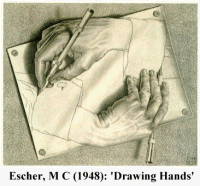
Some 'reflexive' aesthetic practices foreground their 'textuality' - the signs of their production (the materials and techniques used) - thus reducing the transparency of their style. Texts in which the poetic function is dominant foreground the act and form of expression and undermine any sense of a 'natural' or 'transparent' connection between a signifier and a referent. Anti-realist aesthetics involves the principle that 'progressive' texts should reflexively foreground their own construction, their own processes of signification. Postmodernism often involves a highly reflexive intertextuality.
| Reflexivity
In simple audio-visual terms, reflexivity (often referred to as 'self-reflexivity') describes the process by which a film or television programme draws attention to itself, reminding the spectator of its textuality and status as a media construct... The term 'reflexivity' is derived from the Latin reflexio/reflectere meaning 'to bend back on'. Applied to audio-visual practice, by extension of this etymological root, refelxivity refers to the capacity of film and television texts to draw attention to their existence as constructs. It is the process by which texts foreground their authorship and production, acknowledging their status as representation. Within this schema of audio-visual reflexivity, we can identify a series of such devices: strategies of fracture, distanciation, interruption, discontinuity. Stylistic virtuosity, as one example, operates according to these principles, and involves an exaggerated. self-conscious use of style that draws the spectator's awareness to the fact that he or she is watching an audio-visual construction. We become alert to the role of the director and the artifice on which all filmmaking and television production is predicated. Other reflexive strategies draw attention to the formal materials and processes of media construction, literally revealing to the spectator both the tools of production (camera, microphone, lights and so on) and the physical objects of audio-visual communication (for instance, a strip of film). Within this textual focus, it is the medium that becomes the critical area of interest. In popular animated series like The Simpsons and The Ren and Stimpy Show, the animation process is revealed to ironic, comic effect through pastiche and textual reference to production technique. While in Dziga Vertov's Man with a Movie Camera (1929), the filmmaking apparatus is similarly revealed through a systematic focus on the film's own production. Clearly, the reflexive canon encompasses a wide range of devices, the most explicit among them being direct address to the camera, narrative discontinuity, authorial intrusion, essayistic digression, display of process and apparatus, reflexive inter-titles, and other meta-cinematic devices such as the frame-within-a-frame and the film-within-a-film. From the entry for 'Reflexivity'. In Roberta E Pearson & Philip Simpson (2001): Critical Dictionary of Film and Television Theory. London: Routledge, pp. 377-8 |
Here is a classic example of reflexivity in visual art - Escher's 'Drawing Hands'. In what ways is it reflexive?

In no particular order, here are some key features found in reflexive texts (in various media). Find some examples of your own. How could you make your own writing more reflexive?
Functions of Reflexivity
Some suggested reading

|